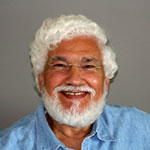August 10, 2011
August 3: How did Mubarak end up in court?
"It is a systemic genocide which lasted 30 years against 88 million Egyptians. This crime is committed by no other than the Mubaraks; the man, his two sons and his wife," wrote Abdul Halim Qandeel in his column of May 5, 2008.
He republished this along with 52 other columns in his landmark book “A Red Card for the President” (2009) – meaning Mubarak must be kicked out like a player in a soccer match committing a serious violation and given the red card.
Qandeel was regularly harassed by Mubarak’s security forces and at one time he was severely beaten and as a result hospitalized. But this did not deter Qandeel who along with 265 other activists signed a document titled “A Founding Statement for the Egyptian Coalition for Change” on April 4th 2009 (a full two years before Mubarak, his two sons and his men were brought before an Egyptian court of law on August 3, 2011)
The statement is included in A Red Card for the President. The 265 activists included politicians from the political right, centre and left, academics, professionals and many of the youth whose names became house hold names after the January 25th Revolution.
Qandeel’s book is very significant because it shows that Egypt’s Revolution was in the making since the year 2000, more than 10 years before the historical day of January 25th. It was reaching out to a wider segment of the population every day and at the same time these people were overcoming the threshold of fear at a steady pace.
Qandeel is an MD who left his practice in 1985 to be a full time political writer.
His book shows that the Mubarak regime was looting Egypt’s national wealth in an unprecedented way resulting in the impoverishment of more than 50% of the population.
He described Mubarak’s men, mostly businessmen, as “murderers” like Ahmed Ezz and Mamdouh Ismail.
Qandeel said that the Mubarak’s regime was following an "Israel First" policy which “brought shame to Egypt" and this policy resulted in the closure of the Rafah crossing “in the face of the brave people of Gaza.”
The book documented the Egyptian call for "No to extension ... No to inheritance" referring to giving Egypt’s top post to Mubarak’s son Gamal.
Qandeel wrote about how “the young facebook generation turned into a popular uprising on April 6, 2008” and he said Mubarak’s regime is "a dying regime".
The book explains how Mubarak came to power by chance in 1981 after the assassination of Sadat and that Mubarak’s aspirations following the 1973 war were to be an ambassador or a head of a public sector company, and he was surprised when Sadat appointed him as Vice President in 1975.
Qandeel charged that Mubarak had turned Egypt into a private company run by him, his family and his men and he was the worst in the history of Egypt. In his 30 year rule Egyptian’s food and water were contaminated and as a result Egypt led the world in kidney failure, hepatitis C and various types of cancers.
Qandeel advocates (remember this was written two years before the revolution) for Mubarak to step down and to be replaced with a transitional council for two years followed with elections. He also said that the way to achieve this is through civil disobedience, protests and peaceful resistance.
He, along with the 265 activists, signed a declaration stating that:
"There is no solution to the crisis in Egypt without a peaceful change of the existing system to the rule of the people through a transitional period of two years in which the country is run by a presidency council and a national coalition government to regain the prestige of Egypt, the prestige and leadership of the Arab world and recover our independence and our national will, and establish a democracy and rule of law and an equitable distribution of wealth, to end the 30-year emergency and to stop political arrests and military trials and to respect the freedom of the press and to allow the formation of political parties, civil associations, trade unions and faculty and student and peasants unions."
The book ends with the list of signatories to this declaration which was used a blueprint for Egypt’s 25th of January Revolution. My hat is off to all of these people. For ten years they were all members in a revolution-in-the-making. I am honored to have met many of them.








